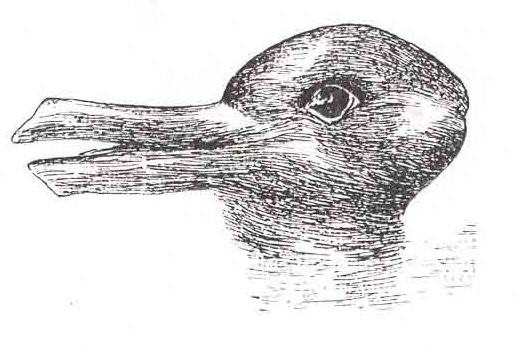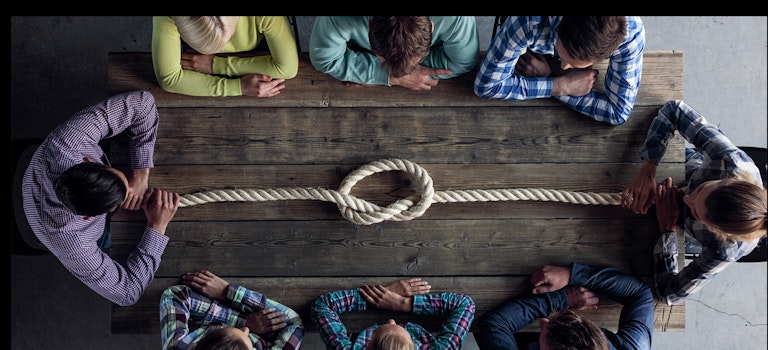On 28 May, Fleur Heyworth is co-directing an intensive workshop ‘Leverage Diversity to Increase Performance’ with Sandrine Tunezerwe, Associate Faculty with the Centre for Creative Leadership and author of an upcoming book on Diversity and Inclusion. She explains why the strategic tool of ‘polarities’, a key tool in many of our leadership courses, including ‘Leading Strategically in Turbulent Times’, will enable participants to lead diversity and inclusion more effectively.
What do you see in the image? It was first produced in Fliegende Blätter, a German humor magazine (Oct. 23, 1892, p. 147) and has since been used by pyschologists and philosophers to explore the workings of the mind. It is described as a paradoxical image because two different images can be seen at the same time.

How often are we able to see and work with two interrelated and yet apparentlycontradictory images, concepts or tensions at the same time? Dealing with and leading tensions are something that we as humans tend to be uncomfortable with. Many of us have been brought up to try to identify and analyse problems, and then find ways to solve them. ‘Theories of change’ aim to take a group or organisation from a given state to a better state. But is this actually an effective strategy that is sustainable over time, and does it in fact reflect the reality?
Take for example, organisational transformation strategies designed to improve the way an organisation works and make it ‘fit’ to meet the challenges of our VUCA world (volatile, unpredictable, complex and ambiguity). How many transformation strategies actually meet resistance, challenge the core culture or expertise of an organisation and forget lessons of the past resulting in failure or inefficiency? In polarity thinking, the strategy will recognise that transformation is in fact in tension with continuity, and we need to do both for enduring success.
In many human relationships and systems, the phenomenon of polarities, also known as paradoxes, contradictions, dilemmas, wicked problems exist. They have been recognised since ancient time: within Taoism, one finds yin and yang, Hinduism embraces masculine and feminine, Christianity espouses justice and mercy, and Martin Luther King advocated both power and love.
Polarities are not always a ‘comfortable truth’; and our own values, fears and cognitive bias can orientate us to one side of a pole, make us defensive of it, and lead to conflict. In addition, as our environment becomes more complex or VUCA, it can be harder to see and lead polarities. However, if we ignore them, we do so at our peril: applying a ‘problem-solving mindset’ can actually make the situation worse rather than better, creating a vicious cycle of negative energy in which we experience the downsides of the tension and conflict
If we can see, map and leverage polarities however, we can create win-win situations. Whilst this phenomenon is ancient wisdom, Barry Johnson has spent around 30 years researching it and developing it to make it strategically useful. Polarity thinking is now recognised as a top strategic tool by the Centre for Creative Leadership and Harvard Business Review. The phenomenon operates at individual, team, organisational and societal levels and many polarities exist within diversity and inclusion strategies.
I am really excited to be able to bring this mindset and tool to advance diversity and inclusion, which entail an interrelated set of tensions that have a significant impact on teams’ performance. I am delighted that Sandrine Tunerzewe, who has years of experience working with organisations and is passionate about busting myths relating to diversity and inclusion and developing concrete practices to lead inclusively. A polarity mindset can dramatically alter the way we consult within our organisations to see ‘both sides of the coin’ and develop a culture that can be sustained over time and across boundaries. Here are some questions to reflect on in preparation for the workshop on May 28th:
- Do you see a tension between uniqueness and equality?
- Are you able to create an environment of psychological safety and invite conflict?
- Are you able to support your people to thrive and drive performance?
- Is your inclusion strategy also creating healthy exclusion?
- Do you have a strong core culture which also welcomes new ideas?
- What diversity-related tensions do you frequently experience in your teams and organisation?
We hope you can join us on the 28th May to develop your ability to 'see, map and leverage' polarities, and share strategies with fellow practitioners and experts to lead them more effectively. In addition, 'Leading Strategically in Turbulent Times' between 3-6 June 2019 will also be using the polarities tool to strategic leverage tensions across your organisation.
